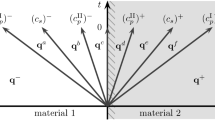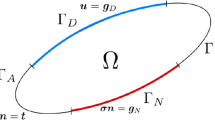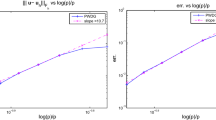Abstract
We use the nodal discontinuous Galerkin method with a Lax-Friedrich flux to model the wave propagation in transversely isotropic and poroelastic media. The effect of dissipation due to global fluid flow causes a stiff relaxation term, which is incorporated in the numerical scheme through an operator splitting approach. The well-posedness of the poroelastic system is proved by adopting an approach based on characteristic variables. An error analysis for a plane wave propagating in poroelastic media shows a convergence rate of O(hn+ 1). Computational experiments are shown for various combinations of homogeneous and heterogeneous poroelastic media.
Similar content being viewed by others
References
Allard, J., Atalla, N.: Propagation of sound in porous media: Modelling Sound Absorbing Materials. Wiley, Hoboken (2009)
Badiey, M., Jaya, I., Cheng, A.H.: Propagator matrix for plane wave reflection from inhomogeneous anisotropic poroelastic seafloor. J. Comput. Acoust. 2, 11–27 (1994)
Biot, M.A.: Theory of propagation of elastic waves in a fluid-saturated porous solid: I. Low frequency range. J. Acoust. Soc. Am. 28, 168–178 (1956)
Biot, M.A.: Theory of propagation of elastic waves in a fluid-saturated porous solid: II. Higher frequency range. J. Acoust. Soc. Am. 28, 179–191 (1956)
Biot, M.A.: Mechanics of deformation and acoustic propagation in porous media. J. Appl. Phys. 33, 1482–1498 (1962)
Cockburn, B., Shu, C.W.: Runge–kutta discontinuous Galerkin methods for convection-dominated problems. J. Sci. Comput. 16, 173–261 (2001)
Coussy, O., Zinszner, B.: Acoustics of porous media. Editions Technip (1987)
Carcione, J.M., Quiroga-Goode, G.: Some aspects of the physics and numerical modeling of Biot compressional waves. J. Comput. Acoust. 3, 261–280 (1995)
Carcione, J.M.: Wave propagation in anisotropic, saturated porous media: Plane-wave theory and numerical simulation. J. Acoust. Soc. Am. 99, 2655–2666 (1996)
Carcione, J.M., Morency, C., Santos, J.E.: Computational poroelasticity—A review. Geophysics 75, 229–243 (2010)
Carcione, J.M.: Wave Fields in Real Media: Theory and Numerical Simulation of Wave Propagation in Anisotropic, Anelastic, Porous and Electromagnetic Media, 3rd edn. Elsevier Science, New York City (2014)
de la Puente, J., Käser, M., Dumbser, M., Igel, H.: An arbitrary high-order discontinuous Galerkin method for elastic waves on unstructured meshes-IV. Anisotropy. Geophys. J. Int. 169, 1210–1228 (2007)
de la Puente, J., Dumbser, M., Käser, M., Igel, H.: Discontinuous Galerkin methods for wave propagation in poroelastic media. Geophysics 73(2008), 77–97 (2008)
Dablain, M.A.: The application of high-order differencing to the scalar wave equation. Geophysics 51, 54–66 (1986)
Dai, N., Vafidis, A., Kanasewich, E.R.: Wave propagation in heterogeneous, porous media: a velocity-stress, finite-difference method. Geophysics 60, 327–340 (1995)
Dumbser, M., Enaux, C., Toro, E.F.: Finite volume schemes of very high order of accuracy for stiff hyperbolic balance laws. J. Comput. Phys. 227, 3971–4001 (2008)
Dupuy, B., De Barros, L., Garambois, S., Virieux, J.: Wave propagation in heterogeneous porous media formulated in the frequency-space domain using a discontinuous Galerkin method. Geophysics 76(4), N13–N28 (2011)
Etgen, J.T., Dellinger, J.: Accurate wave-equation modeling. SEG Technical Program Expanded Abstracts, 494–497 (1989)
Garg, S.K., Nayfeh, A.H., Good, A.J.: Compressional waves in fluid-saturated elastic porous media. J. Appl. Phys. 45, 1968–1974 (1974)
Grote, M.J., Schneebeli, A., Schötzau, D.: Discontinuous Galerkin finite element method for the wave equation. SIAM J. Numer. Anal. 44(2006), 2408–2431 (2006)
Hesthaven, J.S., Warburton, T.: Nodal Discontinuous Galerkin Methods: Algorithms, Analysis, and Applications. Springer Science & Business Media, Berlin (2007)
Hunter, R.J.: Foundations of Colloid Science. Oxford University Press, Oxford (2001)
Käser, M., Dumbser, M., De La Puente, J., Igel, H.: An arbitrary high-order discontinuous Galerkin method for elastic waves on unstructured meshes—III. Viscoelastic attenuation. Geophys. J. Int. 168, 224–242 (2007)
Komatitsch, D., Vilotte, J.P.: The spectral element method: an efficient tool to simulate the seismic response of 2D and 3D geological structures. Bull. Seismol. Soc. Am. 88, 368–392 (1998)
Lemoine, G.I., Ou, M.Y., LeVeque, R.J.: High-resolution finite volume modeling of wave propagation in orthotropic poroelastic media. SIAM J. Sci. Comput. 35, 176–206 (2013)
Levander, A.R.: Fourth-order finite-difference p-SV seismograms. Geophysics 53, 1425–1436 (1988)
LeVeque, R.J.: Finite Volume Methods for Hyperbolic problems. Cambridge University Press, Cambridge (2002)
Özdenvar, T., McMechan, G.A.: Algorithms for staggered-grid computations for poroelastic, elastic, acoustic, and scalar wave equations. Geophys. Prospect. 45, 403–420 (1997)
Pride, S.R.: Relationships between seismic and hydrological properties. Hydrogeophysics, 253–290 (2005)
Sahay, P.N.: Natural field variables in dynamic poroelasticity. SEG Technical Program Expanded Abstracts. Society of Exploration Geophysicists, 1163–1166 (1994)
Santos, J.E., Oreña, E.J.: Elastic wave propagation in fluid-saturated porous media- Part II The Galerkin procedures. Mathematical Modelling and Numerical Analysis 20, 129–139 (1986)
Virieux, J.: P-SV wave propagation in heterogeneous media: Velocity-stress finite-difference method. Geophysics 51, 889–901 (1986)
Ward, N.D., Lähivaara, T., Eveson, S.: A discontinuous Galerkin method for poroelastic wave propagation: The two-dimensional case. J. Comput. Phys. 350(2017), 690–727 (2017)
Wheatley, V., Kumar, H., Huguenot, P.: On the role of Riemann solvers in discontinuous Galerkin methods for magnetohydrodynamics. J. Comput. Phys. 229(3), 660–680 (2010)
Ye, R., de Hoop, M.V., Petrovitch, C.L., Pyrak-Nolte, L.J., Wilcox, L.C.: A discontinuous Galerkin method with a modified penalty flux for the propagation and scattering of acousto-elastic waves. Geophys. J. Int. 205, 1267–1289 (2016)
Zeng, Y., He, J., Liu, Q.: The application of the perfectly matched layer in numerical modeling of wave propagation in poroelastic media. Geophysics 66(4), 1258–1266 (2001)
Acknowledgements
KS would like to acknowledge the School of Geology, OSU and the MCSS, EPFL Switzerland, for providing the fund to carry out this work. We also acknowledge the OGS, Italy for hosting KS at various occasions. We thank editors and three anonymous reviewers for very useful comments. KS would like to acknowledge Sundeep Sharma at Devon Energy, for various discussions and proof-reading the manuscript. This is Boone Pickens School of Geology, Oklahoma State University, contribution number 2019-100.
Author information
Authors and Affiliations
Corresponding author
Additional information
Publisher’s note
Springer Nature remains neutral with regard to jurisdictional claims in published maps and institutional affiliations.
Appendices
Appendix A: Solution of the stiff part
The system of equations represented by (47) is expressed as
The solution of Eqs. (64)–(67) is given as
Appendix B: Computation of λ in (57)
A plane-wave solution for the particle velocity vector V = [vx,vz,qz,qz]T is
where V0 is a constant complex vector and k is wave vector. Substituting (72) in (1)–(4) and (20)–(23) , we recover
where
with Yi(ω) = iωmi + η/κi and lx and lz being direction cosines and \(V=\frac {\omega ^{2}}{k^{2}}\).
Term V in (73) represents the phase velocity of waves and can be computed by adopting the approach for eigenvalue computation. Thus
Energy velocity Ve can be computed from
Appendix C: System of poroacoustic wave equation
This system is
where
with p being the bulk pressure, pf is fluid pressure, v′s and q′s are solid and fluid particle velocity (relative to solid). A1p, B1p, and D1p are defined as
where β’s, H, C, and M are dependent on the solid bulk modulus (Ks), the fluid bulk modulus (Kf), the solid density (ρs), the porosity (ϕ), the permeability (κ), the fluid density (ρf), and the viscosity (η) of the medium, elaborately expressed in [8].
Rights and permissions
About this article
Cite this article
Shukla, K., Hesthaven, J.S., Carcione, J.M. et al. A nodal discontinuous Galerkin finite element method for the poroelastic wave equation. Comput Geosci 23, 595–615 (2019). https://doi.org/10.1007/s10596-019-9809-1
Received:
Accepted:
Published:
Issue Date:
DOI: https://doi.org/10.1007/s10596-019-9809-1




